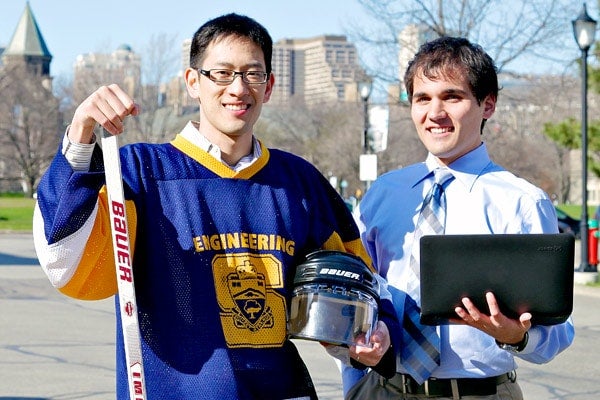
Money puck: changing the way we rate NHL players
Published: May 1, 2012
What the heroes of Moneyball did for baseball, Industrial Engineering Professor Timothy Chan and undergraduate engineering student David Novati are doing for hockey.
As retold in the Oscar-nominated movie, Billy Beane and Paul DePodesta used statistical analysis and nuanced metrics such as on-base percentage and slugging percentage to assemble the Oakland A’s roster beginning in the late 1990s.
Chan and Novati are bringing the same evidence-based sensibility to hockey.
In a paper soon to be published in the journal Interfaces along with a follow-up paper presented at the 2012 MIT Sloan Sports Analytics Conference, Chan and Novati propose a new methodology for quantifying the value of a hockey player.
“Take Sidney Crosby as an example,” Chan said. “Our model considers him a top-tier player because he gets a lot of goals and assists, and generally has a good plus-minus. He adds a lot of value to his team. Now you have other players who are more physical, deliver hits and who get into a lot of fights. Our model says they don’t provide a lot of value to the team, contrary to what some people think.”
A player’s value can determine not only his or her salary, but also influence trades and playing time.
The development of the model began in 2009, not long after Chan arrived at the University of Toronto as an assistant professor in the Department of Mechanical & Industrial Engineering. Collaborating with Novati, who had a keen interest in sports statistics, the industrial engineers started to contemplate how they could apply their knowledge to the Vancouver Winter Olympic Games.
“We started thinking about how we could develop a model that would help predict what the ideal Team Canada hockey team would look like,” said Chan. In the process, they realized a need for a better method to value different player types, the focus of their current research.
Chan and Novati monitor a variety of player performance stats, including goals, assists, hits, blocks, time in the penalty box as well as time on ice. Their model considers a large number of statistics in concert to get an overall picture of a player.
In all, the model established four types of forwards (Top Line, Second Line, Defensive, Physical), four types of defensemen (Offensive, Defensive, Average, Physical), and three types of goalies (Elite, Average, Bottom).
The U of T team is continuing to test and refine their model. Statistics for hockey, unlike baseball, are less plentiful. Eventually they hope to make their statistical model available to the NHL and develop an online tool to help the average hockey fan create their fantasy team.
Novati, who will graduate in June, hopes this research could mean a career in the NHL’s backrooms.



